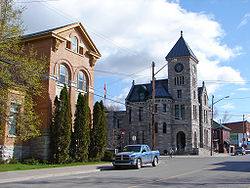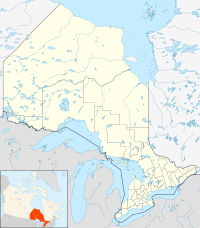- Deseronto
-
Deseronto — Town — Town Hall and Post Office Coordinates: 44°12′N 77°03′W / 44.2°N 77.05°W Country  Canada
CanadaProvince  Ontario
OntarioCounty Hastings Settled 1784 Incorporated 1871 (village) Incorporated 1889 (town) Government – Type Town – Mayor Norman Clark – Federal riding Prince Edward—Hastings – Prov. riding Prince Edward—Hastings Area[1] – Land 2.52 km2 (1 sq mi) Population (2006)[1] – Total 1,824 – Density 724.0/km2 (1,875.2/sq mi) Time zone EST (UTC-5) – Summer (DST) EDT (UTC-4) Postal Code K0K Area code(s) 613 Website deseronto.ca Deseronto is a town in the Canadian province of Ontario, in Hastings County, located on the shore of the Bay of Quinte. The town had a population of 1,824 in the Canada 2006 Census.
The town was named for Capt. John Deseronto, a native Mohawk who was also made a captain in the British Military Forces, and owes much of its cultural heritage and character to the Mohawks of the nearby Tyendinaga Mohawk Territory. The most easterly municipality of Hastings County, it nestles on the shore of Mohawk Bay at the mouth of the Napanee River.
Deseronto, located 5 km from Highway 401, is the eastern gateway to the Bay of Quinte tourist region with the Skyway Bridge providing access to Prince Edward County.
Contents
History
The area was acquired by the British Government from the Mississauga people just after the American Revolution. The land was then granted to Loyalists and Mohawks who had supported the British during this war. In 1784, a group of twenty Mohawk families led by Captain John Deserontyon (c.1740-1811) became the first settlers. Deserontyon's grandson, John Culbertson, inherited his property in what is now the town site. In 1837, Culbertson was granted title to the land, built a wharf on the waterfront, and sold village lots in his tract. A settlement began to grow at the wharf, called Culbertson's Wharf.[2][3]
In 1848, portions of land were bought by Hugo Burghardt Rathbun (1812-1886), Thomas Y. Howe, and L. E. Carpenter who built the area’s first sawmill. By 1850, the village was known as Mill Point. [4] And after 1855, Rathbun acquired many village properties and made Mill Point one of Ontario's earliest company towns to house employees of his shipyard and sawmill. This led to rapid growth and the place became an industrial and transportation hub for the logging business in the Napanee, Salmon, Moira, and Trent River watersheds.[2][3]
In 1871, a county by-law provided for the incorporation of Mill Point as a Village.
Mill Point took the name Deseronto in 1881 in honour of the Mohawk chief Deserontyon who had led the first settlers to the area following the American Revolution. [5] In 1889, it was incorporated as a Town. During the 1890s, Deseronto had a population of about 4000 and was a thriving town with bakeries, drugstores, hardware stores and hotels.[2][3] The town's Post Office, designed by Chief Dominion Architect Thomas Fuller, was completed in 1901.
During World War I, Deseronto was home to two Royal Flying Corps training camps. The Rathbun Company also developed many diversified industries, including a sash and door factory, shipyard, railway car works, terra cotta factory, flour mill, gas works and chemical works, all located in Deseronto. But changing markets, devastating fires, depleting lumber stock, and a lack of good forest management led to the company's decline and they ceased operation in 1923 when they surrendered their charter. Consequently, the town's population fell from 3500 in 1924 to 1300 ten years later.[2]
Much of the land area of the town of Deseronto is part of the Culbertson Tract land claim submitted by the Tyendinaga Mohawks in 1995 and accepted for negotiation by Canada in 2003. The controversy surrounding this has led to recent protests.[6]
Demographics
Population trend:[7]
- Population in 2006: 1824 (2001 to 2006 population change: 1.6 %)
- Population in 2001: 1796
- Population in 1996: 1811
- Population in 1991: 1862
Private dwellings occupied by usual residents: 707 (total dwellings: 758)
Mother tongue:[1]
- English as first language: 92.8 %
- French as first language: 0.5 %
- English and French as first language: 0 %
- Other as first language: 6.7 %
Transit
Deseronto Transit provides public transportation services in the town, with connections to Napanee, Belleville, and Picton.[8]
References
- ^ a b c Statistics Canada 2006 Census - Deseronto community profile
- ^ a b c d "Archives & History". Town of Deseronto. http://deseronto.ca/?page_id=438. Retrieved 2010-01-13.
- ^ a b c Archeological and Historic Sites Board of Ontario
- ^ http://www.heritagefdn.on.ca/userfiles/HTML/nts_1_5664_1.html Ontario Heritage Trust Founding of Deseronto
- ^ http://www.heritagefdn.on.ca/userfiles/HTML/nts_1_5664_1.html Ontario Heritage Trust Founding of Deseronto
- ^ Deseronto hopeful after land claim meeting with government
- ^ Statistics Canada: 1996, 2001, 2006 census
- ^ Town of Deseronto, Deseronto Transit
External links

Tyendinaga Township 
Tyendinaga Mohawk Territory 
Greater Napanee  Deseronto
Deseronto 

Bay of Quinte / Prince Edward Coordinates: 44°11′48″N 77°03′03″W / 44.196638°N 77.050917°W
Categories:- Towns in Ontario
- Municipalities in Hastings County, Ontario
Wikimedia Foundation. 2010.


